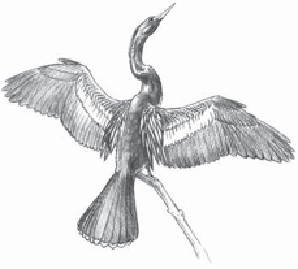Biology Reference
In-Depth Information
Birds often sunbathe. As while passively anting, sunning birds seem to enter into a
trancelike state; they assume strange positions, often leaning to one side and opening
spacesamongalltheirfeathers.Byraisingthetemperatureoftheirskinandfeathers,they
may be driving away parasites or somehow helping to maintain the condition of their
feathers. Sun and wear usually take the heaviest toll on wing and tail feathers.
Birds also bathe in water, snow, or dust. It seems odd to us to imagine bathing in dirt,
but snow and dust baths can scrape off a lot of parasites.
Drying Out
Anhingas, cormorants, pelicans, storks, vultures, and some other birds sometimes sit for
long periods with their wings outstretched to dry them. Anhingas and cormorants spend
alotoftimeunderwaterchasingfish,andinbothcasesfeatherscanbecomequitewet,so
this activity helps dry them. Anhinga feathers are very permeable to water, much more
so than are cormorant feathers. This may help anhingas to swim low and sink into the
water more easily, but because the feathers can become very waterlogged, the birds must
hold their wings out for longer periods than do cormorants. Vultures often stretch their
wings out in the morning. This may help dry feathers that had become wet from rain or
dew overnight.
In all these ways, birds keep their feathers in condition, but even with careful main-
tenance feathers eventually degrade. So birds molt them, replacing each feather usually
at least once, often twice, and in some cases three times a year.
Q A junco with a broken tail has been visiting my feeder. One of my friends said it
would grow back, but the bird has been here for two months and it looks exactly the
same as when it arrived. What is keeping it from growing a new tail?


